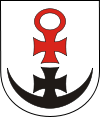Lubin
Lubin [ˈlubʲin] (German: Lüben) is a town in Lower Silesian Voivodeship in south-western Poland. From 1975–1998 it belonged to the former Legnica Voivodeship. Lubin is the administrative seat of Lubin County, and also of the rural district called Gmina Lubin, although it is not part of the territory of the latter, as the town forms a separate urban gmina. As of 2018, the town had a total population of 72,581.
Lubin | |
|---|---|
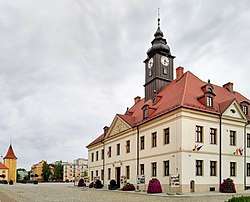 Town Hall | |
 Flag  Coat of arms | |
 Lubin | |
| Coordinates: 51°24′N 16°12′E | |
| Country | Poland |
| Voivodeship | Lower Silesian |
| County | Lubin County |
| Gmina | Lubin (urban gmina) |
| Established | 12th century |
| City rights | 1295 |
| Government | |
| • Mayor | Robert Raczyński (BS) |
| Area | |
| • Total | 40.77 km2 (15.74 sq mi) |
| Population (2018) | |
| • Total | 72,581 |
| • Density | 1,780/km2 (4,600/sq mi) |
| Time zone | UTC+1 (CET) |
| • Summer (DST) | UTC+2 (CEST) |
| Postal code | 59-300 |
| Area code(s) | +48 76 |
| Car plates | DLU |
| Website | http://www.lubin.pl |
Geography
Lubin is situated on the Zimnica river in the Lower Silesian historical region, about 71 kilometres (44 miles) northwest of Wrocław and 20 km (12 miles) north of Legnica.
The town is one of the major industrial locations in Lower Silesia, with the headquarters of the third-largest Polish corporation, the KGHM Polska Miedź mining company.
History
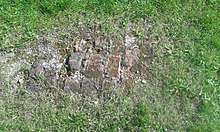
The area of Lubin lies midway between the main settlements of two West Slavic Ślężanie tribes, the Dziadoszanie and the Trzebowianie, whose lands were both subdued by King Mieszko I of Poland about 990. It is unclear which of the two tribes, if either, founded the town. One legend states that the town derives its name from Luba, a young man credited with slaying a giant bear that had been terrifying the inhabitants. A papal bull dated to circa 1155 mentions Lubin as one of 13 Silesian castellanies.
According to legend the Polish voivode Piotr Włostowic of Dunin (1080–1153) had a fieldstone church built on the hill in the west of Lubin, where about 1230 a castellany and a village arose that until today is called the Old Town (Polish: Stary Lubin). The settlement in the Duchy of Głogów was first mentioned under the Old Polish name of Lubin in a 1267 deed by Pope Clement IV as a fiefdom of Trzebnica Abbey.
The New Town of what is today Lubin was probably founded in the 1280s under the rule of Duke Przemko of Ścinawa by German settlers, maybe descending from Lower Lorraine or Franconia, in the course of the Ostsiedlung. It obtained its city rights about 1295. In 1329 Duke John of Ścinawa paid homage to King John of Bohemia, who upon the death of John's brother Duke Przemko II of Głogów in 1331 invaded the lands, which were incorporated into the Kingdom of Bohemia and shared the political fortunes of the Silesian crown land.
_ID_595703.jpg)
From 1348 Lubin Castle served as the residence of the Piast duke Louis I the Fair and his descendants. In the quarrel with his elder brother Duke Wenceslaus I of Legnica a 1359 judgement by Emperor Charles IV allotted Lubin along with Krzeczyn Wielki, Krzeczyn Mały, Osiek and Pieszków to Louis. About 1353 he had a manuscript on the life of Saint Hedwig of Andechs drawn up, later called Schlackenwerth (Ostrov) Codex, which today is kept at the J. Paul Getty Museum. In the late 15th century the Lubin parish church was rebuilt in its present-day Gothic style, its high altar was moved to Wrocław Cathedral in 1951. Under the rule of Duke George I of Brieg (d. 1521) and his widow Anna of Pomerania, the reformer Caspar Schwenckfeld, born in nearby Osiek, made the town a centre of the Protestant Reformation in Lower Silesia. With Bohemian Silesia, Lubin in 1526 fell under suzerainty of the Habsburg Monarchy. It was devastated several times during the Thirty Years' War. Lubin remained part of the Piast-ruled Duchy of Legnica until 1675, when it was incorporated to the Habsburg-ruled Bohemia.
Conquered in the Silesian Wars by King Frederick II of Prussia in the mid-18th Century, the town became a part of Prussia and later, in 1871, Germany. In 1871, after creation of the German Empire, it was connected by rail to Legnica (Liegnitz) and Głogów (Glogau). In reports on their parishes at the end of the 18th century, local pastors wrote about native Poles, who spoke a local dialect of the Polish language. The native Polish population was subjected to planned Germanisation, which lasted until the 1930s.
.jpg)
During World War II about 70% of the town's buildings were destroyed. In 1945 between the days of 8–10 February Red Army soldiers mass-murdered 150 German pensioners in an old-people's home and 500 psychiatric hospital patients in Lubin.[1] As a result of border changes promulgated at the 1945 Potsdam Conference, the town, lying east of the Oder-Neisse line, became a part of the Republic of Poland. The totality of the town's population, being German, was either expelled, or prohibited from returning home by the new Polish Authorities.
In 1982 the town saw significant demonstrations against the martial law declared by the Communist regime, which were put down by its death squads, resulting in the murder of three people.[2][3]
Education
- Uczelnia Zawodowa Zagłębia Miedziowego
- I Liceum Ogólnokształcące im. Mikołaja Kopernika w Lubinie
- II Liceum Ogólnokształcące w Lubinie
- Technikum nr 1 im. Bolesława Krupińskiego w Lubinie
Sports
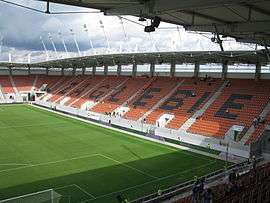
- Zagłębie Lubin - men's Ekstraklasa football team, Polish champion in 1990-1991 and 2006-2007.
- Interferie Zagłębie Lubin - men's handball team playing in Polish Ekstraklasa Men's Handball League (champion of Poland in season 2006/2007) and women's handball team playing in Polish Ekstraklasa Women's Handball League.
- mks zaglebie lubin women soccer,(ekstraliga kobiet(2013/2014)),(ekstraliga).
- kghm zaglebie lubin s.a. ,/(Ekstraliga Kobiet)-(ekstraliga),/(2014/2015),/(Level:1),(Poland),(POL),(women)-soccer).
Transport
Roads: S3 (International E65) – Jakuszyce-Legnica-Lubin-Zielona Góra-Gorzów Wielkopolski-Szczecin-Świnoujście
No. 36 – Rawicz-Lubin-Prochowice(-Wrocław)
Lubin has an international airport with a 1000m concrete/asphalt runway.
Public Transport - Lubin currently has free public transport within the town, with the main busses running approximately every 20 minutes.
Lubin also has the PKS station which offers affordable coach type buses. These buses run between several other towns such as Wroclaw, Legnica and several others.
Currently the city has newly built train station which offers connection to many locations across the country.
Notable people
- William I of Württemberg (1781–1864), the second King of Württemberg from 1816 until his death, was born in Lüben, where his father Frederick I served as a commander in the Prussian Army
- Dieter Collin (1893–1918), World War I flying ace
- Gerd von Tresckow (1899–1944), Wehrmacht officer, resistance fighter 20 July plot, elder brother of Henning von Tresckow
- Rudolf von Gersdorff (1905–1980), Wehrmacht officer, one of the few German military anti-Hitler plotters to survive the war
- Tadeusz Maćkała (born 1962), politician
- Kasia Wilk (born 1982), musician
- Mariusz Jurkiewicz (born 1982), handball player
- Natalia Czerwonka (born 1988), speed skater
- Arkadiusz Woźniak (born 1990), football player
- Adrian Błąd (born 1991), football player
- Filip Jagiełło (born 1997), football player
Gallery
 Gothic Głogów Tower (Baszta Głogowska)
Gothic Głogów Tower (Baszta Głogowska)- Gothic Our Lady of Częstochowa church, 15th century
 Tympanum at the castle's chapel, c.1349
Tympanum at the castle's chapel, c.1349 Cuprum Arena Shopping Center
Cuprum Arena Shopping Center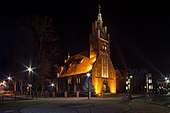 Sacred Heart church
Sacred Heart church Church of the Nativity of the Virgin Mary
Church of the Nativity of the Virgin Mary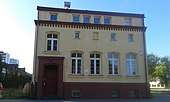 Old guardhouse
Old guardhouse.jpg) Post office
Post office.jpg) Technical school
Technical school.jpg) Wedding Palace
Wedding Palace
References
- Lubin's history
- "Lubin 1982 - wydarzenia z 31 sierpnia 1982, stan wojenny, fotografie - Solidarność, historia współczesna, historia stanu wojennego, ZOMO, milicja, podziemie, władza ludowa, demonstracja, opozycja, Michał Adamowicz, Andrzej Trajkowski, Mieczysławie Poźniak, ofiary". Archived from the original on 2010-07-29. Retrieved 2006-12-15.
- Defiance in the Streets - TIME
- "Partnerschaft mit Lubin / Lüben". rhein-lahn-kreis.de (in German). Rhein-Lahn-Kreis. Retrieved 2020-03-02.
External links
- Official Lubin website
- Photo Gallery - Lubin and Zaglebie
- Lubin Iniquity 1982
- Zaglebie Lubin football club
| Wikimedia Commons has media related to Lubin. |
